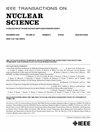连续波x射线科学应用的模拟读出通道
IF 1.9
3区 工程技术
Q3 ENGINEERING, ELECTRICAL & ELECTRONIC
引用次数: 0
摘要
衍射受限存储环对新一代x射线实验,特别是基于连续波操作的实验中所需要的探测器提出了巨大的挑战。现代混合信号读出通道对噪声、功耗和帧速率有严格的要求,要求模拟和数字设计的进步。提出的读出通道,原型快速读出通道用于印刷应用(pFREYA),是为像素化探测器设计的,用于连续波x射线科学应用(例如,印刷),帧速率为1 MHz。它采用商用65纳米CMOS技术开发,具有5、9、18和25 kev光子能量的单光子分辨率,功耗为220~\mu $ W,像素面积为150 $ × 150~\mu $ m2。它还提供了一个2位可切换的峰值时间选择,用于优化信噪比,信号超阈值(SOT)识别,用于零抑制,以及每个通道10位模数转换。在本工作中,将给出读出通道架构的概述,并提供电荷敏感放大器(CSA)和该架构中使用的整形器的表征结果,以及pFREYA通道的噪声性能。本文章由计算机程序翻译,如有差异,请以英文原文为准。
Analog Readout Channel for Continuous-Wave X-Ray Science Applications
Diffraction-limited storage rings are posing huge challenges to the detectors required in new generation x-ray experiments, especially those based on continuous-wave operation. A modern mixed-signal readout channel demands strict requirements on noise, power consumption, and frame rate, asking for advancements in both analog and digital designs. The proposed readout channel, prototype fast readout channel for ptychography applications (pFREYA), is designed for pixellated detectors to be employed in continuous-wave X-ray science applications (e.g., ptychography) with a frame rate of 1 MHz. It is developed in a commercial 65-nm CMOS technology and features single photon resolution at 5-, 9-, 18-, and 25-keV photon energies, a power consumption of $220~\mu $ W, and a pixel area of $150\times 150~\mu $ m2. It also offers a 2-bit switchable peaking time selection for signal-to-noise ratio optimization, signal-over-threshold (SOT ) identification for zero-suppression, and 10-bit analog-to-digital conversion per channel. In the present work, an overview of the readout channel architecture will be given, and results from the characterization of the charge sensitive amplifier (CSA) and the shaper employed in the architecture will be provided, in addition to the noise performance of the pFREYA channel.
求助全文
通过发布文献求助,成功后即可免费获取论文全文。
去求助
来源期刊

IEEE Transactions on Nuclear Science
工程技术-工程:电子与电气
CiteScore
3.70
自引率
27.80%
发文量
314
审稿时长
6.2 months
期刊介绍:
The IEEE Transactions on Nuclear Science is a publication of the IEEE Nuclear and Plasma Sciences Society. It is viewed as the primary source of technical information in many of the areas it covers. As judged by JCR impact factor, TNS consistently ranks in the top five journals in the category of Nuclear Science & Technology. It has one of the higher immediacy indices, indicating that the information it publishes is viewed as timely, and has a relatively long citation half-life, indicating that the published information also is viewed as valuable for a number of years.
The IEEE Transactions on Nuclear Science is published bimonthly. Its scope includes all aspects of the theory and application of nuclear science and engineering. It focuses on instrumentation for the detection and measurement of ionizing radiation; particle accelerators and their controls; nuclear medicine and its application; effects of radiation on materials, components, and systems; reactor instrumentation and controls; and measurement of radiation in space.
 求助内容:
求助内容: 应助结果提醒方式:
应助结果提醒方式:


